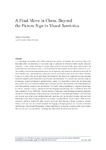Mostrar o rexistro simple do ítem
A final move in chess. Beyond the picture sign in visual Semiotics
| dc.contributor.author | Sonesson, Goran | es_ES |
| dc.date.accessioned | 2014-10-02T12:31:54Z | |
| dc.date.available | 2014-10-02T12:31:54Z | |
| dc.date.issued | 2012 | es_ES |
| dc.identifier.citation | Culture of communication / Communication of culture, 2012: 1397-1407. ISBN: 978-84-9749-522-6 | es_ES |
| dc.identifier.isbn | 978-84-9749-522-6 | es_ES |
| dc.identifier.uri | http://hdl.handle.net/2183/13430 | |
| dc.description.abstract | [Abstract] It is something of a paradox that, within semiotics, the science of meaning, there has been fairly little discussion about the specificity of the picture sign, in particular in relation to other visually conveyed meanings. In fact, visual semiotics is mostly about pictures and picture-like signs such as film and audiovisual means of communication, to which architecture and sculpture may be added, whereas in actual fact visually conveyed meaning includes most of what happens in the theatre and indeed in everyday life. In recent decades, new interdisciplinary endeavours such as visual studies and visual culture have pretended to take on a wider field, but as such these conceptions do not seem to be endowed with any adequate theoretical apparatus permitting them to go beyond mere description. If we admit that, with the exception of language, human perception is predominantly visual, it is reasonable to think that all phenomena conveyed by the visual senses have something in common, but then visual semiotics will comprehend much more than painting, sculpture, and architecture. The double coding hypotheses of cognitive psychology, as well as Lessing’s classical opposition between language and painting, tell us something about this basic opposition. In my 1989 book, Pictorial concepts, I discussed some philosophical and psychological conceptions of the specificity of the picture sign, from Husserl to Goodman and Wolheim, and I also took into account some other visual artefacts that carry meaning, such as the tailor’s dummy and wax food. John Searle’s discussion of representation involves many examples that are visual in nature. More recently, «cognitive artefacts» (which are often visually conveyed) have become a theme in cognitive science. Chess, which was used as a central metaphor for language and signs generally by a number of thinkers from Saussure, Husserl and Wittgenstein to Searle and Deacon, is certainly a cognitive and visual artefact. But we must start from perception – including the visual world on non-human animals | es_ES |
| dc.language.iso | eng | es_ES |
| dc.publisher | Universidade da Coruña | es_ES |
| dc.title | A final move in chess. Beyond the picture sign in visual Semiotics | es_ES |
| dc.type | info:eu-repo/semantics/conferenceObject | es_ES |
| dc.rights.access | info:eu-repo/semantics/openAccess | es_ES |






